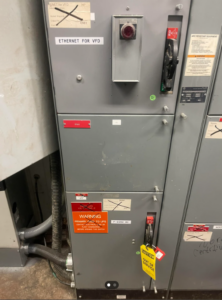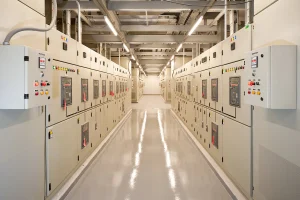Switchgear and MCC are critical components in electrical distribution systems, each serving a distinct function. Switchgear is generally for protecting and isolating downstream electrical equipment vs an MCC that provides central control and protection for motors across a facility. This article reviews what switchgear and MCC are and compares the features of a switchgear vs an MCC.
What is a Switchgear
Switchgear houses a variety of switching and safety devices that help to regulate, protect, or isolate electrical equipment. Typically, switchgear includes components like circuit breakers, transfer switches, relays, transformers, and a grounding system, all within an enclosure. Switchgear usually has a compartmentalized setup, so it is easy to group equipment into subsystems. This improves isolation and control. The exact components in a switchgear will vary according to its application, but it can generally perform the following functions:
- Protective relay systems detect issues like short circuits or overloads and send a signal to trip the circuit breaker, interrupting the current flow.
- Operators can also utilize disconnect switches to manually de-energize equipment for isolation during maintenance.
- The fuses in the system provide overcurrent protection by its element melting and opening circuits.
- Current transformers (CTs) are standard features that step down current levels for measurement by protective relays and meters.
- Also, voltage transformers (PTs) are key features for converting high voltages to lower levels so monitoring instruments can measure them.
- From a rating standpoint, there are two types of switchgear: Metal Clad and Metal enclosed. Metal Clad is constructed with grounded barriers between internal compartments, while Metal Enclosure does not. Depending on the construction type, ANSI and NEMA ratings can both apply.
What is an MCC
MCC, a Motor Control Center, is an electrical assembly that enables the control and protection of all or some motors in a facility from a central location. Generally, it serves in large commercial or industrial applications. The structure of MCC consists of multiple enclosed sections having common busbars and individual motor starters, fuses, or circuit breakers. Consequently, advanced MCC might contain additional components like PLCs, VFDs, automatic fault detection, and remote monitoring systems. The key feature of an MCC is that its contactors are designed for many repeatable operations as opposed to a circuit breaker. It also enables efficient power management and provides organization and safety in managing power distribution. Some of the standard components of MCC are:
- Motor Control Units: They house the switches, contactors, and circuits to run the MCC.
- The Horizontal Bus: Connects the primary power source to the individual vertical bus sections.
- The Vertical Bus: Also known as the power busbar. It enables power connections to several starter units.
- Controlling and monitoring: The software or network connectivity systems like PLCs, VFDs, and soft starters.
Differences Between a Switchgear vs an MCC
In simple terms, An MCC is a cabinet filled with buckets containing starters, relays, and other components. Meanwhile, switchgear is a free-standing device that powers feeder circuits to various loads like MCCs. It can control and protect the electrical equipment within multiple subsystems. Moreover, the following section highlights the key differences between the MCC and switchgear.
Interface and Structure
If we look at the interface, the switchgear control panel includes switches, indicators, handles, and a display monitor to start, break, and regulate the electricity. Meanwhile, its physical structure involves different busbars, circuit breakers, protection relays, and feeders. On the other hand, an MCC interface includes a cabinet with switches, displays, indicators, an emergency stop button, and an HMI for adjusting the motor controlling parameters. The main internal components are busbars, ventilation, and buckets, which house the motor starter, relays, etc.
Standards of Switchgear vs MCC
Several industry standards provide guidance that covers aspects of both switchgear and MCCs. Moreover, these standards ensure their safe and reliable design, manufacturing, and installation. For MCCs, NEMA ICS 18 provides requirements regarding covering ratings, construction, and performance. Also, NEMA ICS 1 and 2 offer additional guidelines on the performance and safety of MCCs. NEMA and ANSI C37 also provide guidance for switchgear, with the SG 5 and SG 6 covering switchgear assemblies, performance, safety, and low-voltage power circuit breakers. The NFPA 70 provides guidelines on installing electrical wiring and equipment such as switchgear and MCCs. There are several other relevant standards for this equipment, including IEC 61439-1, IEC 61439-2, and UL 845.
Voltage Ratings of Switchgear vs MCC
Switchgears are typically rated from 1kV to 36kV, a wide application range. Ratings higher than 36kV are possible, but those high-voltage switchgear usually serve in power stations and transmission networks. On the other hand, MCCs are used for motor circuits from 230 V to less than 1000 V. However, MCCs can work up to 15K V for large industrial motors. The following table highlights voltage ratings for this equipment and their common applications.
| Type | Voltage Range | Applications |
| Low Voltage Switchgear | Up to 1KV | Residential, commercial, as well as industrial power control |
| Medium Voltage Switchgear | 1 to 35 KV | Industrial utility and commercial power distribution |
| High Voltage Switchgear | 35+ KV | Large-scale transmission |
| Low Voltage MCC | Up to 600V | Industrial and commercial motor control |
| Medium Voltage MCC | 600 to 15KV | Large industrial motors |
Cost
Although both systems have different fundamental purposes, MCCs are cheaper to manufacture because of their simple design and lower initial setup cost. Switchgear’s high cost is due to its complexity and advanced protection features, which require higher equipment and manufacturing costs. However, the cost of any particular MCC or switchgear depends on factors like voltage capability, complexity, and component quality.
Safety and Reliability
While switchgear and MCC are typically constructed with two separate purposes and design characteristics, both have proven to be very reliable and safe to own, maintain, and operate, provided all safety features and practices suggested by the manufacturer are adhered to. Also, safety practices in accordance with NFPA 70E should always be observed when working in and around electrical distribution equipment of any kind.







